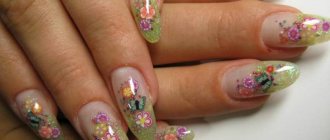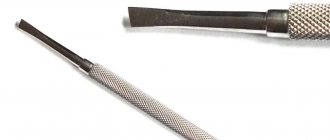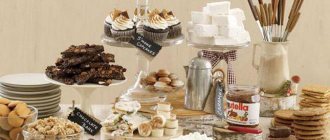To a person uninitiated in the mysteries of confectionery art, it may seem that assembling a tiered cake is as easy as shelling pears. It would seem that he made three cakes of different sizes and placed one on top of the other. All!
But it's not that simple in reality. After all, an incorrectly constructed structure can collapse or creep apart. A lopsided Leaning Tower of Pisa can ruin the festive mood, and is unlikely to produce the desired effect.
By the way, it is important to correctly calculate the diameter of each tier, so you will achieve ideal proportions and avoid wasting food.
To ensure that everyone is happy, and the master does not have to blush for his work, there are a number of assembly rules. A beautifully assembled cake will certainly delight and demonstrate the talent of the pastry chef.
Important! When creating a 3-tier cake, make the bottom layer of sponge cake with thick cream. It will be a strong foundation for the entire structure.
Pros and cons of multi-tiered cakes
This spectacular dessert has its advantages and disadvantages :
Pros:
- a wide variety of cake layers, creams, finishing and decoration methods . Moreover, the tiers can have different tastes;
- the opportunity to highlight the style of the wedding celebration;
- allows you to feed all guests due to its large size.
Minuses:
- high cost (can cost 5 times more than a standard single-tier product);
- difficulty in calculating the required amount of dessert;
- the need to order in advance , in popular confectionery shops - several months in advance;
- risk of damage to complex structures during transportation and storage.
Assembling a multi-tiered cake
The principle of strengthening a cake with more than two tiers is approximately the same as for its smaller counterpart. But there are some secrets here:
- The cakes need to be covered with mastic and cooled. And only then start assembling the cake.
- You will only need one skewer here. All tiers of festive delicacies will be planted on it. You will also need straws and white chocolate.
- Before you start assembling, wrap the skewer on top with cling film. We stick the stick in the middle, and around it at a distance of about 3 cm we make holes with tubes. The straws will need to be removed. Just like in a two-tier cake, they need to be cut to fit the height of the tiers.
- Next, the white chocolate is melted and, using a bag or bag, poured into the holes made by the tubes. Then the tubes need to be returned to where the chocolate was poured.
- We place the second, third and subsequent tiers, except for the top one, on a skewer and on top of each other in the same way. And we just put the last one on top. It is important to ensure that the skewer does not pierce through it.
Now all that’s left to do is to fully decorate this beauty and not drop it when it’s taken out to the guests.
Assembling a cake with cream from several tiers is also possible, but the product will be more fragile. It is necessary to decorate the dessert with cream after the tiers are connected to each other.
That's how many ways there are to assemble cakes! And this is not the limit. But in any case, if you follow the instructions given, your delicacy will not fall apart and will be the pride and main decoration of any holiday!
Fixation methods
There are several options for serving and fixing the product, depending on the weight, recipe of cakes and creams (mastic, mousse, layers, etc.):
- A regular stand of the required size on which the lower tier of the dessert is placed. All subsequent layers rely on the bottom one.
- A stand with a number of holder trays corresponding to the number of tiers of the cake , fastened with a common rod or separate clamps.
- Multi-tiered stand , the design of which allows you to place the required number of portioned cakes according to the number of guests. In this serving option, the bride and groom can take their share of the dessert home.
Stands and holders for cakes can be purchased in specialized stores or rented at a pastry shop when ordering a wedding treat.
The principle of assembling a multi-tiered product (for any version of the recipe) is based on the use of a frame made from scrap materials or pastry wire.
How and why to strengthen a cake
The pastry shop often asks questions about strengthening multi-tiered cakes. But the question most often is posed like this: “Do we need to strengthen it?”
and
“What to strengthen?”
.
Accordingly, the answers to these questions are given - “yes, it is necessary”
and
“you can strengthen it with this and this.”
Those.
what a question, such an answer. Moreover, the answers are correct. Because the main question is “Why is the cake strengthened?”
was not asked.
More precisely how? Everyone knows that they strengthen it “so as not to fall apart
,” but the principle of strengthening is understood only by those who answer the questions
“should it be strengthened and with what
,” but no one asked them about the principle)).
Why? Because they were afraid that they would be considered incompetent.. As a result, those who asked and received the answer “yes, it’s definitely necessary.. with skewers.. about 8 pieces”
simply stuck sticks into the cakes
(well, excuse me.. I got this feeling)
,
which are not really will not strengthen, but rather ruin the cake. So - skewers, etc.
they are needed in the cake not at all so that the client’s life does not seem like honey, not so that he spits them out, and not even in order to add more work to you)). So, WHY is the cake attached?
Many of those who make “cakes of any complexity from any photo”
They sincerely believe that it is possible to put tier on tier
(and so there are 10 pieces... well, it’s like that in the photo))
. God only knows why the thought does not occur to them that all cakes are tender - poke your finger and there will be a dent. Now imagine that they will put one, two or three more cakes on top of the cake, all of which at once with their weight will put pressure on the bottom one, and each one separately on the previous one? Only the top one will survive... and that’s if it doesn’t fall, after all the lower ones have mowed down.
And now a digression:
Has everyone seen how a multi-storey building is built?
Pit, foundation, supports, floors... Why not put it directly on the asphalt without a foundation? Why are there concrete piles there if you can put a box on top of a box? But no one asks why piles and a foundation are needed).. The principle of strengthening the cake is the same - transfer the weight of the entire structure to a stand (not a backing!) for the cake, which plays the role of a foundation.
So, let's introduce the terminology:
- cake stand
- the essence of the foundation
(a load-bearing structure, part of the structure (in our case, a cake), which takes all the loads from the overlying structures (in our case, tiers) and distributes them along the base)
- substrates for all tiers of the cake
- the essence of the ceiling
(a horizontal internal protective structure that separates adjacent rooms (in our case, tiers) in height in a structure (in our case, in a cake). As a rule, this is a load-bearing structure)
- skewers
- the essence of supports
(elements of a structure that serve to install parts (in our case, tiers) on the foundation and supporting structures, the main function of which is to transfer force from one part of the structure to others or to the foundation.).
- central skewer
- the essence is the main central axis, which is also the axis of symmetry - the center of gravity of a symmetrical section necessarily lies on the axis of symmetry
(with the sincere belief that your cakes do maintain symmetry). Used in three or more tier cakes... it makes no sense in a two-tier cake.
I won’t bother you with inertia and the main moments of inertia; in this post it’s not important... just
keep in mind that the main central axis is as important as the “foundation”, “supports” and “floors”.
Foundation (
stand
), supports (
skewers, including the central one
) and ceilings (
substrates
)
are load-bearing structures
, which automatically answers the question “what should they be?”
— tough and durable!!. if the substrate is not rigid, then glue two together (with chocolate, icing, etc.. and not PVA, “Moment”, epoxy)
.. and make the supports not from rubber and straw.
===================
And now it’s clear
I for the quality of the illustrations - I drew it quickly and in Word... well, in general, I think it’s clear).
Let's assume that we need to build a three-tier cake (Fig. 1)
, where
h1
is the height of the first tier,
h 2
is the height of the second tier,
h 3
is the height of the third tier.
and r 1
,
r 2
,
r 3 (Fig. 2)
are the radii of the corresponding tiers of the cake
(just in case, I’ll clarify that the diameter ( d) of the tier is equal to two radii (d=2r )
Your task is to transfer the weight of the second
and
the third
tier on
the stand
so that they do not put pressure on
the first
(presses the weight of
2
and
3
) and
the second
(presses
the third
) tier.
(Fig.3)
substrate 1
should have a diameter equal to the diameter of
tier 1
,
substrate 2
and
substrate 3
- respectively, to the diameters of
2
and
3
.
n1
=
d 1
;
n2
=
d2
;
_ p3
=
d 3
The length of the skewers for fastening each specific tier is strictly equal to the height of the given tier:
k1
=
h 1
;
k 2
=
h 2
;
k 3
=
h 3
skewers should be cut evenly at the bottom and top and insulated from the cake (I insulate them with cocktail straws)
stuck into the cake approximately according to this scheme (Fig. 4)
The scheme is not the only one, but it is canonical and most convenient.
The basic principle is that the length from the center of the cake to the skewer furthest from the center should be less than the radius of the base of the next tier, i.e.
l1
<
r 2
;
l2
<
r 3 ( etc., if there are more than three tiers)
.. the topmost tier is not pierced with skewers - because it makes no sense.
Top view (Fig. 5)
Separate discussion about the central axis
(O)
- in Fig.
2-4 it is shown in red. The central mount has a through passage exactly in the center of all tiers, except for the top one, into which it enters from below by 2-3 cm, depending on the height of the final tier. L axis
=
h 1
+
h 2
++
2-3 cm.
We need to make through holes strictly in the center
in the first tier
,
in the substrate of the second tier, in the second tier
,
in the substrate of the third tier
and a hole 2-3 cm deep in the third tier.. BOTTOM, if anything)) All this is done during the manufacturing process of each tier, but not during the final assembly.
There is no need to pick at the covered cakes - prepare all the holes in the tiers and bases at the stage of applying the finishing layer (cream) under the covering. The tiers are best secured to the bases with chocolate. I think it’s unnecessary to remind you that the substrates should be hard and clean, and that the cakes themselves should be perfectly even both in diameter and height. Geometry and compasses will help you.
And also a faithful eye and an unwavering hand. Well, don’t forget that the central mount should also be isolated from the cake. Assembly
- take a stand
under the cake, apply chocolate to it to glue
the backing of the first tier (we do not apply it over the entire stand, naturally.. we focus on the diameter of the first tier).
the first tier
of the cake
on the stand (it is on a base, the diameter of the base is equal to the diameter of the tier.. the tier has a through hole strictly in the middle, the base of the first tier does not have a hole)
- insert
the central fastener
the first tier until it stops
at the base 1
- measure the distance
l 1
from the center of the tier, insert
4 skewers
until they stop into
the backing
.
if you cut them correctly and if you have an even cake, then they will all be at the same level as the height of the tier - not recessed or protruding. If they stick out, take them out and cut them off. Then 4 more skewers
- closer to the center
(see Fig. 4)
- I seal the punctures with chocolate - at the same time the next backing of the next tier is glued to it.
- we install the second tier (it is also on a substrate, the diameter of the substrate is equal to the diameter of the tier.. the substrate and the tier have through holes strictly in the middle) on the first
, stringing it onto
the central fastener
- measure the distance
l 2
from the center of the tier, insert
4 skewers
until they stop
base 2
.. then
4 more
.. the principle is the same as with the first tier
(if the diameter of the tier is less than 15-16 cm, then 4 skewers are enough, otherwise you will only damage the cake)
- if there are more tiers to the top, then do this Well... if there are three, then we “string”
the top one
.
Now let’s take a closer look at Figure 3 Third
The (top) tier rests on
the backing
, which presses
on the fastenings of the second tier
, which rest on the
backing of the second tier
, which, in turn, presses
on the fastenings of the first tier
, which rest on the
backing of the first tier
, which lies on
the cake stand
.
Does the upper
tier put pressure on
the second
and
first
?
No! puts
all his weight .
Does the second
tier put pressure on
the first
- also no - the weight also
goes to the stand
.
This is the meaning of attaching the cake and assembling it correctly.
===== The questions arise: “What should the stand be like?”, “What diameter should the skewers and the central axis be?” Empirical experience will help you - I think you’ll guess that it won’t hold up with matches, but there’s no point in sticking a log. It all depends on the weight, diameter and height of the tiers. Good luck with all of your designs, girls.
Storage and transportation conditions
Transportation of the prepared dessert is carried out either by the manufacturing company (a separate paid service) or by the wedding organizers. Professionals prefer to use special containers of suitable shape and machines with a cooled cargo compartment .
When delivering by the manufacturing company, semi- finished products are often delivered - cakes, cream, finishing elements - and assembled on a stand at the site of the celebration .
When transporting yourself, you need to take care of suitable-sized transport, a box and careful delivery to the place . It is better to transport the product together.
The cake in a container or box is placed on a flat, hard surface (! not on a seat!) and held motionless. Use cold generators to maintain temperature.
Storage conditions for wedding dessert depend on its composition and the manufacturer’s recommendations. The usual temperature range is 5-12 degrees Celsius, humidity no more than 50% .
Below in the photographs you will see examples of two-tier and three-tier wedding cakes.
3 tiers:
2 tiers:
4 tiers:
Assembling a two-tier cake
This is an easier process than making a monumental dessert weighing more than a dozen kilograms, but it still requires a reverent attitude. To prevent the cake from sagging or warping, it is necessary to strengthen its base.
The cake should be assembled already when the tiers are covered with mastic. So, one skewer will need to be inserted into the cake to measure its depth and cut it exactly to this length. The cocktail tube also needs to be cut to the same length and the stick inserted into the straw. In the middle we stick this structure into this tier. We do the same thing 5-6 more times, placing the sticks with tubes around the center, as if in the shape of a flower.
Now you can simply place the second mastic-covered tier on top. The cake is not deformed. Next, all that remains is to decorate it completely.
Price
The average cost of a multi-tiered wedding cake is 800-1700 rubles per kilogram , the cost of decoration is calculated separately (usually for each tier).
Designer decoration, original recipes and making dessert according to customer sketches/recipes add 20-50 % to the price. Reputable confectionery shops offer free tasting and/or delivery to the venue at a discount.
The number of tiers, design, recipe are discussed with the customer. The minimum weight of the cake is determined by the manufacturer (usually from two kilograms per tier).
Put the cake on the scales
Typically, the weight of a wedding cake is calculated based on the number of grams per guest. The proportion is quite simple to calculate: for one guest - 200 g of cake. Thus, we get that for 10 guests you will need a cake weighing 2-2.5 kg, for 20 people - 4-5 kg, and so on. The more guests, the heavier the cake will be.
However, there is one important nuance that should be taken into account when deciding on the weight of the cake - the composition of the filling. If you order a cake with a light base (for example, mousse and airy cakes), then calculating its weight using the “gram/person” formula, you risk finding yourself in a situation where the portions will be huge. Guests simply won’t be able to cope with them, which means the money will be wasted.
The second option is a dense, heavy filling, for example, cakes soaked in liquor and filled with a thick layer of chocolate on top. In this case, the cake may turn out to be too small and not enough for all guests.
Therefore, the proportions in these two cases will be different:
- For light compositions - 150-200 g of cake per guest;
- For heavy compositions - 200-250 g of cake per guest.
Go to the wedding cakes section of our catalog.
How to beautifully decorate a two-tier cake
Today, professional confectioners are free to fantasize with dessert decorations. Whole berries, cookies, waffles, mirror glaze or jelly and even fresh flowers are used. However, not every novice pastry chef is able to immediately create such masterpieces. In order not to spoil the almost finished cake, it is enough to use simple decorations and an abstract design. Here are some ideas:
- Meringue. Prepare curly meringues in the oven in advance - you can add food coloring and flavoring to them to suit your tastes. This kind of decoration is very convenient to use, since dry things are always easy to fix if something doesn’t work out the first time.
- Cream. Using a pastry bag with different attachments, you can make all kinds of flowers and borders. The cream can also be flavored and tinted to suit any design.
- Patterns and inscriptions. They are made with topping (caramel, chocolate, condensed milk), fruit syrups or cream using a narrow nozzle.
- Powder. You can use the classics - chocolate or cake crumbs, crushed or flaked nuts, and if you wish, buy ready-made sugar decorations - multi-colored sticks, balls, letters, stars.
- Unusual solutions. If you like modern trends, stock up on chocolate-covered nuts or crisps, ready-made chocolates in interesting shapes, or jelly products, arranging them according to your preferences.
- A two-tier wedding cake can be decorated with figures of a young couple, and a birthday cake can be decorated with three-dimensional letters or numbers, which are bought or ordered from craftsmen.
Making your own cake base
A distinctive feature of “multi-story” cakes is their height, so most often the cake layers of such products are sponge cakes. You can create as many tiers as needed - the principle will be the same: each new layer is narrower than the previous one, the height can be the same or less.
If you don’t have molds of different diameters, you can prepare two identical cake layers, and then cut one of them, cover with a plate of the desired size and run a knife along the contour. Skillful housewives even manage to use scraps to create an additional tier, because the joints can be masked with cream. And also from them you can get several portioned cakes according to the same recipe, which are convenient to give to guests to take away.
To make a tasty and durable sponge cake, be sure to use vanillin and beat the eggs and sugar well. If it is possible to bake the cakes at the same time, everything is prepared at once. When the oven is weak, it is better to arrange the layers one by one. Then the products are divided into two parts: equally for identical cakes or in a ratio of 5:3.
For a two-tiered preparation you will need the following ingredients:
- eggs – 8 pcs.;
- sugar – 350 g;
- flour – 300 g;
- vanillin – 1 sachet;
- cocoa – 4–6 tbsp. l. (added if necessary);
- cinnamon and other additives - if necessary.
- First you need to beat the eggs with sugar into a stable foam with medium-sized bubbles - the quality of the cake depends on this. The mass should double in volume.
- Sift the flour, add vanillin and gradually add it to the resulting mixture, stirring thoroughly. If you want a chocolate or spicy cake, all bulk ingredients are first added to the flour so that the dough is uniform in taste and color (the finished foam cannot be mixed intensively).
- This cake is baked in a mold lined with cooking paper at 180–190 degrees for about 40–45 minutes. It is not advisable to open the oven during the process so that the sponge cake does not settle. When it's browned, check for doneness with a toothpick. The dough should not stick to the piece of wood. Cool the cakes by wrapping them in a towel - then they remain fluffy.
In the case of pre-preparing the sponge cake, it is advisable to keep the cooled crumpets in a cool place, but no longer than 8 hours, so that they do not become stale. However, it is better not to do this - the cake will only be tasty if all the ingredients are fresh.
If the cream requires cooling, it is prepared while the cakes are baking; otherwise, it is better to make it while the sponge cake is cooling. Remember that foamy creams can change consistency and cannot be left standing.










